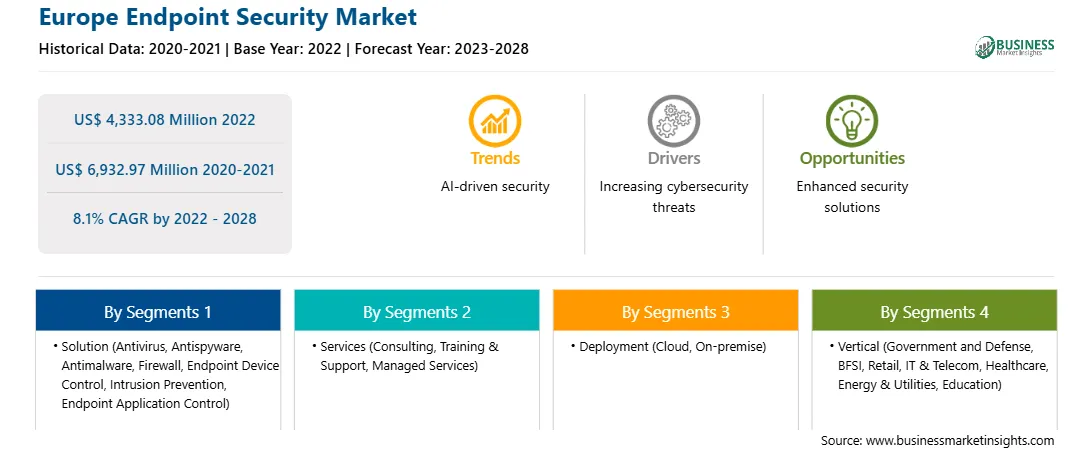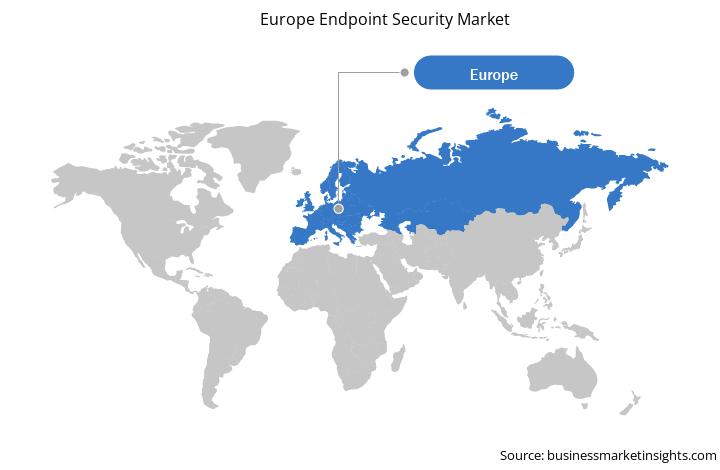The endpoint security market in Europe is expected to grow from US$ 4,333.08 million in 2022 to US$ 6,932.97 million by 2028. It is estimated to grow at a CAGR of 8.1% from 2022 to 2028.
Widening adoption of BYOD model
The information technology infrastructure has grown more complicated and heterogeneous over the past five years due to the introduction of new platforms, BYOD (bring your own device) regulations, CYOD (choose your own device) trends, business apps, and other technologies. The trends of BYOD and CYOD are becoming common in business settings due to the rapid developments in mobile computing. As a result of these developments that are implemented by different organizations, employees can access organizational data through mobile devices from anywhere, 24/7. As customers become more tech-savvy and their lifestyles become more mobile, it is no wonder new technologies are making their way into the office. The BYOD movement is gaining popularity among both large and small enterprises. Due to the flexibility of devices, employees have a great deal of control and convenience over when and how they carry out and complete their work. A BYOD strategy can enhance not only employee morale but also productivity, creativity, communication, and cooperation. For years, even before the COVID-19 outbreak, businesses began shifting to BYOD policies. This made practical and interpersonal sense to some extent. On the practical side, users/employees operate more efficiently on their personal devices, such as laptops and mobile devices. On the interpersonal level, users feel more at ease using those technologies, which fosters positive attitudes about their work. However, as organizations adopted this more open-ended and free-form endpoint policy, they began to face additional issues. First, keeping a close eye on all of the devices connected to the network proved difficult; second, delivering a consistent layer of cybersecurity across all of the countless connecting devices was a new issue. As a result of increased cases of cyberattacks due to the adoption of BYOD models, businesses are purchasing endpoint security services to secure devices, such as smartphones, tablets, desktop computers, and laptops, that are present on office premises and those with remote access to the corporate network. The market for endpoint security is anticipated to rise due to the large increase in expenditure on endpoint security solutions and services.
Market Overview
Germany, France, the UK, Russia, and Italy are among the major economies in Europe. With the growing competitive rivalry in the regional marketplace, increasing incidence of sophisticated endpoint attacks and breaches, and proportionally surging demand for high-security solutions to combat endpoint attacks, European businesses are increasingly adopting security solutions to secure the exponentially rising number of endpoint devices. The European data strategy aims to make the European Union (EU) a leading data-driven society by creating a single market for data that allows the free flow of data among businesses, researchers, and public administrations across sectors such as healthcare, government & defense, IT & Telecom, BFSI, healthcare, education, and energy & utilities in the EU. Further, individuals and organizations will be empowered to make better decisions based on insights from non-personal data that does not contain personal identity information as the connection of endpoint devices such as mobile phones, Internet-of-things devices, laptops, tablets, and other devices to corporate networks which creates attack paths for security threats. The endpoint security solution and services also help ensure that vulnerable devices follow a definite level of compliance with standards as they have the protection software in it. Further, the Data Governance Act adopted by the European Commission in November 2020 boosts data-sharing across sectors and member states in Europe. The act also provides support for the set-up and development of common European data spaces in strategic domains of private and public companies in the healthcare, energy, environment, agriculture, finance, mobility, manufacturing, and public administration sectors, among others.
Strategic insights for the Europe Endpoint Security provides data-driven analysis of the industry landscape, including current trends, key players, and regional nuances. These insights offer actionable recommendations, enabling readers to differentiate themselves from competitors by identifying untapped segments or developing unique value propositions. Leveraging data analytics, these insights help industry players anticipate the market shifts, whether investors, manufacturers, or other stakeholders. A future-oriented perspective is essential, helping stakeholders anticipate market shifts and position themselves for long-term success in this dynamic region. Ultimately, effective strategic insights empower readers to make informed decisions that drive profitability and achieve their business objectives within the market. The geographic scope of the Europe Endpoint Security refers to the specific areas in which a business operates and competes. Understanding local distinctions, such as diverse consumer preferences (e.g., demand for specific plug types or battery backup durations), varying economic conditions, and regulatory environments, is crucial for tailoring strategies to specific markets. Businesses can expand their reach by identifying underserved areas or adapting their offerings to meet local demands. A clear market focus allows for more effective resource allocation, targeted marketing campaigns, and better positioning against local competitors, ultimately driving growth in those targeted areas.
Europe Endpoint Security Strategic Insights

Europe Endpoint Security Report Scope
Report Attribute
Details
Market size in 2022
US$ 4,333.08 Million
Market Size by 2028
US$ 6,932.97 Million
Global CAGR (2022 - 2028)
8.1%
Historical Data
2020-2021
Forecast period
2023-2028
Segments Covered
By Solution
By Services
By Deployment
By Vertical
Regions and Countries Covered
Europe
Market leaders and key company profiles
Europe Endpoint Security Regional Insights

Europe Endpoint Security Market Segmentation
The Europe endpoint security market is segmented into solution, services, deployment, and vertical.
AO Kaspersky Lab; Avast Software s.r.o.; Cisco Systems, Inc.; ESET, spol. s r.o.; Fortinet, Inc.; McAfee, LLC; Microsoft Corporation; Palo Alto Networks, Inc.; Bitdefender; and F-Secure are the leading companies operating in the endpoint security market in the region.
The Europe Endpoint Security Market is valued at US$ 4,333.08 Million in 2022, it is projected to reach US$ 6,932.97 Million by 2028.
As per our report Europe Endpoint Security Market, the market size is valued at US$ 4,333.08 Million in 2022, projecting it to reach US$ 6,932.97 Million by 2028. This translates to a CAGR of approximately 8.1% during the forecast period.
The Europe Endpoint Security Market report typically cover these key segments-
The historic period, base year, and forecast period can vary slightly depending on the specific market research report. However, for the Europe Endpoint Security Market report:
The Europe Endpoint Security Market is populated by several key players, each contributing to its growth and innovation. Some of the major players include:
The Europe Endpoint Security Market report is valuable for diverse stakeholders, including:
Essentially, anyone involved in or considering involvement in the Europe Endpoint Security Market value chain can benefit from the information contained in a comprehensive market report.